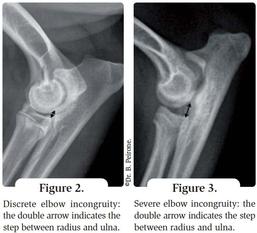DanBar Ranch
An ununited anconeal process (UAP) is characterized by disease of a part of the ulna bone at the elbow joint. This process (protruberance) of the ulna bone fails to form properly and, because of this, the function of the elbow is affected and osteoarthritis develops.
There is NO WAY to know if a dog has elbow dysplasia without x-ray examination. "Breeders" who tell you otherwise, or try to convince you that they "know" their dogs are ED free without x-ray examination are simply scamming you.
Health Testing: ELBOW DYSPLASIA
Dogs with UAP develop osteoarthritis (degenerative joint disease) of the elbow, which causes pain. The disease is often present by 5-9 months of age but can show later. Affected dogs may be treated with rest and pain-killers, and treatment may need to be life-long. Various surgical procedures have been recommended to treat or alleviate the condition but there is no consensus as to which is best. Some procedures require major intervention, eg removal of sections of bone. UAP leads to pain and disability associated with the osteoarthritis of the elbow joint. This can be mild to severe.
Elbow dysplasia can be extremely debilitating, unfortunately there is no satisfactory surgical procedure that can significantly alter the progression of the disorder or cure it.
Above: x-ray showing elbow dysplasia.
TESTING AVAILABLE FOR ELBOW DYSPLASIA
The Orthopedic Foundation for Animals (OFA) offers x-ray screening for ED.
Here at DanBar Ranch I use the tried and true OFA screening process. Dogs are sedated, x-rayed and films sent to the OFA. Three expert orthopedic veterinarians read all films and then decide if elbows are "normal" or "abnormal". Abnormal results will be graded on severity.
The OFA will give out a final "official" rating only after the dog is 24 months of age. However, it will read films of younger dogs and these are called "prelims". The OFA states on its website that the correlation between the rating of a prelim being the same as the final reading is better than 95%.
CAIRNS: according to OFA statistics (as of 2019) there is no data, as less than 50 members of the breed have been tested! This is depressing indeed, that so few breeders care to know about the health of their breeding dogs.
DOBERMANS: according to OFA statistics, of the over 3,000 Dobermans tested since 1974, and which owners agreed to allow the results to be published, 99% of the dogs have normal elbows. Bear in mind many people, finding out from their local vet who takes the x-rays that their dog will not pass, do NOT send in the films, thus skewing the results. Elbow dysplasia does exist in the Doberman breed, and it is important that breeders who want to keep them a viable working breed test their breeding dogs for this debilitating disease.
Buyer beware...
I have spoken out for years that breeders who consider themselves "ethical" MUST screen their breeding dogs and MUST report to the OFA all results - pass or fail. Why? Because without that information researchers cannot help our breeds, and puppy buyers can't be made aware of the REAL risks they face for specific disease in the breed of their choice.
So why do so very few breeders take this simple but so important step for their dogs and breed? Sadly, the excuses are many... Some suggest the cost is prohibitive. But in reality, most puppy buyers would rather pay a slight increase in purchase price to thousands in veterinarian bills when they discover their dog has a preventable disease later in life.
Some "breeders" claim to do health testing but insist they don't feel the need to pay the small fee to register it with the OFA. It is hard to know if they are being truthful, as some breeders have been known to have ONE x-ray of a dog with excellent features, which they show to the unknowing puppy buyer as "proof" that which ever dog they need to be x-rayed, is, indeed, x-rayed. Add to that the fact that the average puppy buyer does not know what they are looking at in an x-ray, and will be fooled by whatever the "breeder" tells them. This is why the OFA has a panel of specialist evaluating the films!
Bottom line, a serious and ethical breeder SUPPORTS the OFA in the very important research they do. Sure, it hurts the ego to send in a dog you own or bred that may not pass a health screening, but the resulting information that gives researchers and fellow breeders is SO important to the welfare of the breed. Putting the breed first means walking the walk, not just talking the talk.





